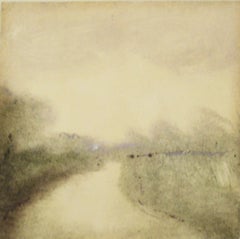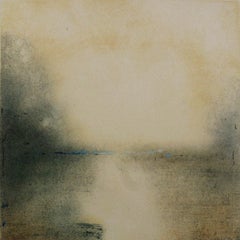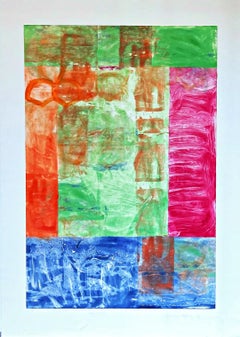Lisa Breslow Abstract Prints
to
2
Overall Width
to
Overall Height
to
1
14
633
205
165
164
2
2
2
2
Artist: Lisa Breslow
Lisa Breslow "River's Edge" Monotype on Paper
By Lisa Breslow
Located in New York, NY
Both the natural world and architectural grit have a place in Lisa Breslow's work, highlighting the pull of New York City that is created by these opposing forces side-by-side. She ...
Category
Early 2000s Lisa Breslow Abstract Prints
Materials
Monotype
Lisa Breslow "Meditation 16" Monotype on Paper
By Lisa Breslow
Located in New York, NY
Both the natural world and architectural grit have a place in Lisa Breslow's work, highlighting the pull of New York City that is created by these opposing forces side-by-side. She ...
Category
Early 2000s Contemporary Lisa Breslow Abstract Prints
Materials
Monotype
Related Items
New Moon, signed monotype print by renowned contemporary abstract artist
By Andrea Belag
Located in New York, NY
Andrea Belag
New Moon, 1990
Monotype on Wove Paper
42 × 30 inches
Hand signed and dated on the front
Published by Pelavin Editions, with blind stamp on the front
Unique
Unframed
Love...
Category
1990s Contemporary Lisa Breslow Abstract Prints
Materials
Monotype, Lithograph
Drift Apart, Infinity Elipse in Blue Tones, Horizontal Diptych, Minimalist Style
By Kind of Cyan
Located in Barcelona, ES
This is an exclusive handprinted unique cyanotype that takes its inspiration from the mid-century modern minimalist shapes.
"Drift Apart" it's made by layering paper cutouts and diff...
Category
2010s Post-Minimalist Lisa Breslow Abstract Prints
Materials
Paper, Monotype
Wave III, Unique Monotype Cyanotype, Horizontal Diptych of
By Kind of Cyan
Located in Barcelona, ES
Wave III, is an exclusive handmade cyanotype horizontal diptych that captures the gentle curl of an organic mid-motion wave. Rendered in deep Prussian blues and ethereal whites, the...
Category
2010s Abstract Geometric Lisa Breslow Abstract Prints
Materials
Paper, Monotype
Woven Spiral, Blue and White Abstract Horizontal Diptych, Monotype Cyanotype
By Kind of Cyan
Located in Barcelona, ES
Woven Spiral is an exclusive handmade cyanotype diptych that features modern, abstract rocky shapes rendered in deep indigo tones. Each panel captures the raw texture and organic geo...
Category
2010s Contemporary Lisa Breslow Abstract Prints
Materials
Paper, Monotype
Venice Seascape Triptych, Blue Lido Island Reflections, Contemporary Cyanotype
By Kind of Cyan
Located in Barcelona, ES
This series of cyanotype triptychs showcases the beauty of nature scenes, including stunning beaches and oceans, as well as the intricate textures of water, forests, and skies. These...
Category
2010s Contemporary Lisa Breslow Abstract Prints
Materials
Lithograph, Monotype, Paper
$744 Sale Price
20% Off
H 40 in W 83 in
Mid-Century Shapes, White and Blue Abstract Shapes, Handmade Cyanotype Monotype
By Kind of Cyan
Located in Barcelona, ES
This unique monotype cyanotype, rendered in rich blue tones, draws inspiration from mid-century modern shapes to explore themes of balance and duality. Abstract forms echo harmony an...
Category
2010s Post-Modern Lisa Breslow Abstract Prints
Materials
Paper, Watercolor, Lithograph, Monotype
Seven Seas, Organic Abstraction Diptych, Indigo Blue Unique Monotype Cyanotype
By Kind of Cyan
Located in Barcelona, ES
Seven Seas is a one-of-a-kind cyanotype monotype, created using traditional cyanotype printing techniques and a contemporary eye for form, this diptych captures the rhythmic motion o...
Category
2010s Contemporary Lisa Breslow Abstract Prints
Materials
Paper, Monotype
Birds Included (floral, still life, watercolor, bright colors, flowers, birds)
Located in New York, NY
Monotype and watercolor on paper
44 x 33 inches framed
Category
2010s Contemporary Lisa Breslow Abstract Prints
Materials
Paper, Watercolor, Monotype
$4,600 Sale Price
20% Off
H 41 in W 30 in
Vertical Folds, Unique Monotype Cyanotype in Blue Tones, Organic Shapes, Paper
By Kind of Cyan
Located in Barcelona, ES
This is an exclusive handprinted unique cyanotype that takes its inspiration from the modern mid-century minimalism style.
It's made by layering paper cutouts and different exposures...
Category
2010s Post-Minimalist Lisa Breslow Abstract Prints
Materials
Paper, Monotype
Orbiting Masses, Blue and White Abstract Diptych, Monotype Cyanotype on Paper
By Kind of Cyan
Located in Barcelona, ES
Orbiting Masses is an exclusive handmade cyanotype diptych that features modern, abstract rocky shapes rendered in deep indigo tones. Each panel captures the raw texture and organic ...
Category
2010s Contemporary Lisa Breslow Abstract Prints
Materials
Paper, Monotype
Estate No. 091013
By Otto Neumann
Located in New Orleans, LA
Otto Neumann (1895-1975) was a German Expressionist painter and printmaker. His monotypes evolved from sharp, angular, black and whites to late abstract p...
Category
1960s Expressionist Lisa Breslow Abstract Prints
Materials
Monotype
Mid-Century Shapes, White and Blue Abstract Shapes, Handmade Cyanotype Monotype
By Kind of Cyan
Located in Barcelona, ES
This is an exclusive handprinted unique cyanotype that takes its inspiration from the mid-century modern shapes.
It's made by layering paper cutouts and different exposures using uv-...
Category
2010s Post-Minimalist Lisa Breslow Abstract Prints
Materials
Watercolor, Lithograph, Monotype, Paper
Lisa Breslow abstract prints for sale on 1stDibs.
Find a wide variety of authentic Lisa Breslow abstract prints available for sale on 1stDibs. You can also browse by medium to find art by Lisa Breslow in monotype and more. Not every interior allows for large Lisa Breslow abstract prints, so small editions measuring 22 inches across are available. Customers who are interested in this artist might also find the work of Pia Fries, James Coignard, and Sayed Haider Raza. Lisa Breslow abstract prints prices can differ depending upon medium, time period and other attributes. On 1stDibs, the price for these items starts at $1,500 and tops out at $1,500, while the average work can sell for $1,500.
Artists Similar to Lisa Breslow
Questions About Lisa Breslow Abstract Prints
- Who posed for the Mona Lisa?1 Answer1stDibs ExpertApril 26, 2024Lisa Gherardini del Giocondo is likely the person who posed for the Mona Lisa. She was the wife of a wealthy Florentine silk merchant. Historians have arrived at this conclusion based largely on the biography of Leonardo da Vinci written by Giorgio Vasari. On 1stDibs, explore a large collection of Old Masters art.
- 1stDibs ExpertMay 3, 2024The real story of the Mona Lisa may never be known for certain. However, most art historians believe that Lisa del Giocondo, the wife of a silk merchant from Florence, posed for the painting. Biographies of Leonardo da Vinci and other historical documents from the Italian Renaissance suggest that the del Giocondos commissioned the work to hang in their new home and to mark the occasion of the birth of their son. On 1stDibs, find a large selection of fine art.
- 1stDibs ExpertAugust 8, 2024Leonardo da Vinci actually painted the Mona Lisa. Although works of fiction, including novels and films, have led some people to falsely believe that the work was secretly created by someone else, there is no historical evidence to support this. Interestingly, there is a very similar painting in the collection of the Museo del Prado in Madrid, Spain. Called La Gioconda, it was most likely painted by one of da Vinci's apprentices and completed while the master artist worked on the Mona Lisa. On 1stDibs, explore a large collection of fine art.
- 1stDibs ExpertSeptember 9, 2024It is difficult to say for certain how much the Mona Lisa is worth today. Experts estimate that the painting may be worth upwards of $860 million, but unless the painting comes up for auction, it can be difficult to predict how much it could sell for. The masterpiece painted by Leonardo da Vinci has been part of the Louvre's collection since 1797. On 1stDibs, shop a diverse assortment of fine art.
- 1stDibs ExpertNovember 13, 2024Why the Mona Lisa is called La Gioconda is because of the identity of the woman widely believed to be shown in Leonardo da Vinci's masterpiece. Many art historians consider that the portrait depicts Lisa Gherardini, the wife of an Italian merchant named Francesco del Giocondo. In Italian, "La" is the feminine form for the word "the." Changing "Giocondo" to "Giaconda" is a way to make the last name feminine. Put simply, “La Gioconda” means "the wife of Giocondo" and describes who Lisa Gherardini was. Explore a wide variety of fine art on 1stDibs.
- 1stDibs ExpertJanuary 27, 2025The museum in Paris that has one of the richest collections of paintings, including the famous Mona Lisa, is the Louvre. Established in 1793, the museum has displayed fine works of art for over 200 years. Each year, more than 8.7 million people visit the Louvre. Its collections include more than 35,000 paintings, sculptures and other objects. On 1stDibs, shop a large selection of fine art.



